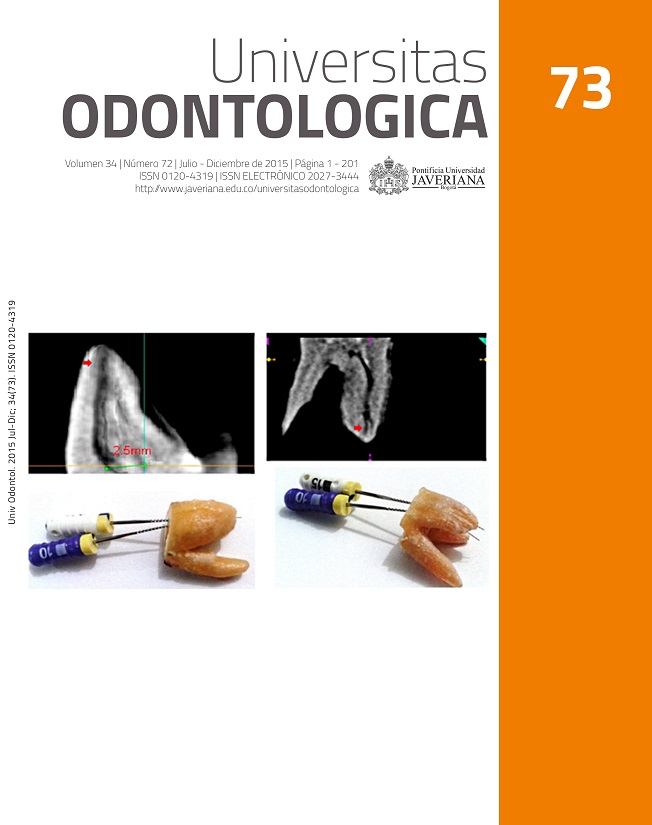Resumen
RESUMEN. Antecedentes: Es importante en la práctica clínica que los instrumentos rotatorios usados estén estériles para evitar infecciones cruzadas. Objetivo: Evaluar la efectividad del proceso de esterilización de las limas primarias WaveOne® con el propósito de fundamentar su reutilización. Métodos: Se evaluaron 50 limas primarias WaveOne®, 10 nuevas y 40 usadas en conductos mesovestibulares de molares con diagnóstico de periodontitis apical y necrosis pulpar. Las limas usadas se esterilizaron mediante la prueba de esterilidad establecida por la farmacopea 35 europea y japonesa. Resultados: Las 10 limas WaveOne® primarias, sin uso, no mostraron crecimiento de microorganismos. En el grupo 2, las 40 limas WaveOne® primarias usadas una vez y esterilizadas tampoco mostraron crecimiento de microorganismos. Conclusiones: El proceso de esterilización de las limas primarias WaveOne® fue satisfactorio. Además las limas primarias WaveOne®, como lo indica el fabricante, vienen estériles en su empaque.
ABSTRACT. Background: It is important that rotary instruments used in clinical practice are sterile to avoid cross-infection. Objective: To evaluate the effectiveness of the sterilization process of Primary WaveOne® files, in order to support their reutilization. Methods: The sample consisted of 50 Primary WaveOne® files, 10 new and 40 used to prepare mesio-vestibular root canals of molars with diagnosis of pulp necrosis or apical periodontitis. Files in group 2 were sterilized and tested through the protocol described at the European and Japanese Pharmacopoeia 35. Results: The 10 new Primary WaveOne® files did not show microorganism growth. The 40 sterilized files of group 2 did not show growth of microorganisms either. Conclusions: The process of file sterilization was effective. In addition, WaveOne® Primary files, as indicated by the manufacturer, come in sterile packaging.
Pinheiro E, Gomes B, Ferraz C, Sousa E, Teixeira F, Souza F. Microorganisms from canals of root-filled teeth with periapical lesions. Int Endod J. 2003; 36(1): 1-11.
Todd P, Whitney S, Walker S, Friedman S. Microbial contamination of endodontic files received from the manufacturer. J Endod. 2006; 32(7): 649-51.
Linsuwanont P, Parashos P, Messer H. Cleaning of rotary nickel-titanium endodontic instruments. Int Endod J. 2001; 37: 19-28.
Johnson M, Primack P, Loushine R, Craft D. Cleaning of endodontic files, part I: the effect of bioburden on the sterilization of endodontic files. J Endod. 1997; 23(1): 32-4.
Parashos P, Linsuwanont P, Messer HH. A cleaning protocol for rotary nickel-titanium endodontic instruments. Aust Dent J. 2004; 49(1): 20-7.
Aasim S, Mellor A. The effect of pre-soaking and time in the ultrasonic cleaner on the cleanliness of sterilized endodontic files. Int Endod J. 2006; 39: 143-9.
Dentsply India. Products. Weybridge, UK: Dentsply IH Ltd.; 2014. Consultado: marzo 2014. Disponible en línea en: http://dentsply.co.in/catalog/wave%E2%80%A2one%E2%84%A2-file.
Berutti E, Chiandussi G, Paolino D. Canal shaping with WaveOne primary reciprocating files and Protaper system: a comparative study. J Endod. 2012, 38(4): 505-9.
Wave One- Endodoncia- Sistema reciprocante de lima única. Dental Tv Web; 2010. Consultado: marzo 2014. Disponible en línea en: http://www.dentaltvweb.com/producto/wave-one-endodoncia-sistema-reciprocante-de-lima-unica.
Berutti E. Root Canal Anatomy preservation of WaveOne reciprocating files with or without glide path. J Endod. 2012; 38(1): 101-4.
Berutti E, Chiandussi G. Effect of canal length and curvature on working length alteration with WaveOne reciprocating files. J Endod. 2011; 37(12): 1687-90.
The U.S. Pharmacopeial Convention. USP 35-NF 30. United States Pharmacopeial and the National Formulary. 2012. Disponible en línea en: http://www.usp.org/.
Parirok H, Asgary S, Eghbal MJ. An energy dispersive X-ray analysis and SEM study of debris remaining on endodontic instruments after ultrasonic cleaning and autoclave sterilization. Aust Dent J. 2005; 31(2): 53-8.
Smith A, Lettersa S, Langeb A, Perrettc D, McHugha S, Bagga J. Residual protein levels on reprocessed dental instruments. J Hosp Infect. 2005; 61: 237-41.
Sonntag D, Ove A. Effect of prion decontamination protocols on nickel-titanium rotary surfaces. J Endod. 2007; 33(4): 442-6.
Venkatasubramanian R, Jayanthi, Das U, Bhatnagar S. Comparison of the effectiveness of sterilizing endodontic files by 4 different methods: An in vitro study. J Indian Soc Pedod Prev Dent. 2010; 28(1): 2-5.
Van Eldik D, Zilm PS, Rogers AH, Marin PD. A SEM evaluation of debris removal from endodontic files after cleaning and steam sterilization procedures. Aust Dent J. 2004; 49(3): 128-35.
Bourvis N, Boelle P, Cesbron J, Valleron A. Risk assessment of transmission of sporadic Creutzfeldt-Jakob disease in endodontic practice in absence of adequate prion inactivation. PLoS ONE. 2007; 12: 13-30.
Lemmer K, Mielke K, Georg P, Beekes M. Decontamination of surgical instruments from prion proteins: in vitro studies on the detachment, destabilization and degradation of PrPSc bound to steel surfaces. J Gen Virol. 2004; 85: 3805-16.
Esta revista científica se encuentra registrada bajo la licencia Creative Commons Reconocimiento 4.0 Internacional. Por lo tanto, esta obra se puede reproducir, distribuir y comunicar públicamente en formato digital, siempre que se reconozca el nombre de los autores y a la Pontificia Universidad Javeriana. Se permite citar, adaptar, transformar, autoarchivar, republicar y crear a partir del material, para cualquier finalidad (incluso comercial), siempre que se reconozca adecuadamente la autoría, se proporcione un enlace a la obra original y se indique si se han realizado cambios. La Pontificia Universidad Javeriana no retiene los derechos sobre las obras publicadas y los contenidos son responsabilidad exclusiva de los autores, quienes conservan sus derechos morales, intelectuales, de privacidad y publicidad.
El aval sobre la intervención de la obra (revisión, corrección de estilo, traducción, diagramación) y su posterior divulgación se otorga mediante una licencia de uso y no a través de una cesión de derechos, lo que representa que la revista y la Pontificia Universidad Javeriana se eximen de cualquier responsabilidad que se pueda derivar de una mala práctica ética por parte de los autores. En consecuencia de la protección brindada por la licencia de uso, la revista no se encuentra en la obligación de publicar retractaciones o modificar la información ya publicada, a no ser que la errata surja del proceso de gestión editorial. La publicación de contenidos en esta revista no representa regalías para los contribuyentes.


